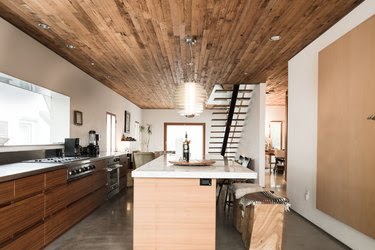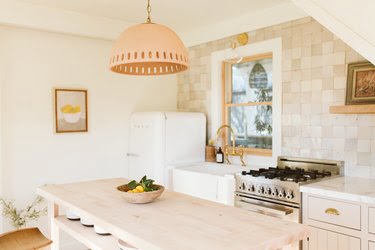Quck answer
Choosing the right kitchen island lighting is important to create a functional and stylish space. Consider the size and layout of your kitchen, as well as the style and color scheme. Pendant lights are popular choices for kitchen islands, providing focused task lighting. Chandeliers can add a touch of elegance and provide overall ambient lighting. Under-cabinet lights can also be installed to enhance visibility and create a warm atmosphere. It is crucial to ensure that the lighting fixtures are properly installed and positioned to avoid shadows and glare. Ultimately, the right kitchen island lighting will enhance the functionality and aesthetic appeal of your kitchen.
If you’ve always desired a kitchen island and now you finally have one, you may find yourself overwhelmed in the lighting aisle of your local home improvement store. There are numerous options available to illuminate your kitchen island, but don’t worry, there are guidelines to help you make the right choice.
These tips are a great starting point, but remember that they are not strict rules. Ultimately, it’s about what you prefer and what works best in your kitchen. Even if your chosen lighting breaks the rules, as long as it looks good to you, it doesn’t matter.
Understand the Purpose of Your Kitchen Island
Before worrying about the appearance of your light fixture, consider its functionality. For example, if you have a small kitchen, a ceiling-mount light that provides ambient lighting for the entire room and the kitchen island may be a good option. Recessed ceiling lights can also serve as ambient lighting and effectively illuminate your island, provided that the light layout ensures that one or two lights will be positioned above it.
If the ambient lighting is insufficient for your island countertop, you will need task lighting to make working at the island easier. Task lighting should direct light onto your work surface, making downward-facing pendant lights a suitable choice. If your ceiling is high, use hanging fixtures to bring the light closer to you.
Understanding your needs will help you determine which light fixtures can fulfill them and which ones may disappoint.

Image Credit: Stephen Paul
Height of Kitchen Island Lighting
When deciding how high to hang your kitchen lighting, you can start from the bottom or the top. According to Better Homes & Gardens, light fixtures should hang 12 to 20 inches below an 8-foot ceiling. If your ceiling is taller, add 3 inches for each additional foot of height.
Alternatively, you can measure from your kitchen island upwards. To ensure adequate task lighting without glare, leave 30 to 36 inches of space between the top of your kitchen island and the bottom of your hanging light fixture. Ideally, the lights should be positioned perfectly between the ceiling and the countertop. However, in reality, you may need to choose one of these measurements and make adjustments accordingly.
The kitchen is the heart of the home, and many families spend a significant amount of time there. If your light fixture ends up hanging at eye level and potentially obstructing conversation across the island, make adjustments. You can raise chandeliers and single fixtures, opt for smaller minipendant lights, or choose fixtures with glass shades and a more open design. If using pendant lights, you can also vary the heights to add visual interest and ensure unobstructed views.

Photo Credit:
Peter Schweitzer
How Many Light Pendants and How Far Apart?
When it comes to pendant fixtures for kitchen island lighting, the number of pendants to hang and the distance between them depends on various factors. As a general guideline, Del Mar Fans & Lighting suggests that the spacing between pendant lights should be equal to the width of each pendant.
If you prefer a mathematical approach, you can take it a step further. To determine the appropriate width of the light pendant fixtures above your island, start by measuring the length and width of your kitchen island in feet. Subtract 1 foot from the length and another foot from the width. Then, add the new width and depth together. This calculation will give you the maximum width in inches for your pendant lighting fixtures.
To determine the spacing between the pendant lights, measure the length of your island in inches and subtract 12. Divide the resulting number by the ideal light width calculated in the previous step. Finally, divide this number by two to determine the number of lights needed.
Kitchen Island Lighting: Blending In or Standing Out
Your kitchen island is not just an isolated element but a part of the overall kitchen space. Therefore, it is important for the kitchen island lighting to harmonize with the rest of the room. This does not mean that the lighting fixtures have to match perfectly with the other lights, but they should fit in a way that makes sense.
In order to ensure that your kitchen island lighting complements the rest of the room, try to match it with something else. For example, you can choose a metal light fixture that matches the cabinet door pulls or the kitchen faucet. Additionally, consider the style of your kitchen. If your kitchen has a rustic or laid-back atmosphere, avoid installing a fancy crystal chandelier over the island. For more modern kitchens, a single long and minimalist LED bar light above the island may be a suitable choice.
If you prefer your kitchen island lighting to blend in rather than stand out, opt for light fixtures that match a significant portion of the space, such as the cabinets or countertops. Glass fixtures can also be used to avoid introducing new colors to the space, or fixtures that resemble bare light bulbs. Ceiling mount lighting and recessed lights are also less conspicuous and do not obstruct your line of sight.

Photo Credit:
Sanford Creative
Other Considerations for Kitchen Island Lighting
When selecting kitchen island lighting, take into account both practical considerations and aesthetics. Drum lights and chandeliers sometimes feature fabric lamp shades, which can be difficult to clean, especially if they are placed near the stove where grease accumulates.
Be cautious with pendant lights that have open bottoms, as they expose the light bulbs inside. While this may not bother you, it can cause glare for children who are helping in the kitchen. Choose fixtures that have enclosed bottoms to hide the bulbs, or install the lights on a dimmer switch to adjust them as needed.
The Importance of Light Bulbs
When illuminating your kitchen island, the type of light emitted by your fixtures is just as crucial as the appearance of the fixture itself. For task lighting, it is ideal to use a light bulb with a kelvin range of 2,700 to 3,500. These lights are close to neutral, producing a white light rather than a blue or yellow one. However, if your kitchen has a very modern feel, you can opt for a slightly cooler light, or if your kitchen decor leans towards warmer tones, you can choose a slightly warmer light.
Considering LED bulbs is always a good idea. These bulbs have a longer lifespan compared to traditional incandescent bulbs and consume less energy. They also remain cool, ensuring that your kitchen lighting does not add more heat to an already warm area of your home. Some LED lights are quite bright, making them an excellent choice for wall-mounted fixtures above your island rather than hanging fixtures. The brightness of the LED lights will ensure that the workspace is adequately lit, even if it is further away.
The Benefits of a Dimmer Switch
Regardless of the type of light you choose for your kitchen island, it is highly recommended to install it with a dimmer switch. A dimmer switch allows you to increase the brightness when you need task lighting, such as when working on a school science fair project, and decrease it for a romantic dinner for two.
With a dimmer switch, your kitchen island lighting can serve as task lighting when necessary and even as ambient lighting on cloudy days when a little extra light is enough to fill the room. It can also function as accent lighting, allowing you to turn off the other lights in the room and focus solely on your island. Furthermore, a dimmed light can double as a night light when you crave a midnight snack.
You can also consider adding toe-kick lighting to your island. This type of accent lighting is installed at the bottom of the kitchen island, shining downwards onto the floor. When turned on, toe-kick lights create the illusion that the island is floating and draw attention to this prominent kitchen feature in a subtle yet effective way. Toe-kick lighting also serves as a great night light for late-night snacking.
Are Pendant Lights Overwhelming?
While searching for kitchen island lighting, you may come across an overwhelming number of pendant light fixtures. It is also common for salespeople to immediately steer you towards pendant lights as soon as you mention the words “kitchen island.” This is because pendant lights are versatile and popular choices for islands. However, other options deserve more attention than they typically receive.
You can choose to install a ceiling-mounted light above your kitchen island, which works particularly well when the island is positioned in the middle of the room. You have the option of a flush-mount light that attaches directly to the ceiling or a short light that hangs just a few inches below it. These lights will cast a wide beam and provide ample island lighting if they are sufficiently bright. Additionally, you do not need to worry about them hanging down and creating a cluttered look. You can even select a fixture with both a light and a ceiling fan if you prefer to stay cool while you work.
Another excellent choice for lighting in kitchens with low ceilings is recessed lighting. This type of lighting is ideal because it doesn’t appear too large or obtrusive. When using recessed lights as task lighting over a kitchen island, it’s best to select lights that have a diameter of 3 to 5 inches. It’s important to note that certain recessed lights are specifically designed to address unique lighting challenges. For instance, there are recessed lighting cans created for shallow ceilings that are not very thick, as well as for sloped ceilings where achieving even lighting can be difficult.

